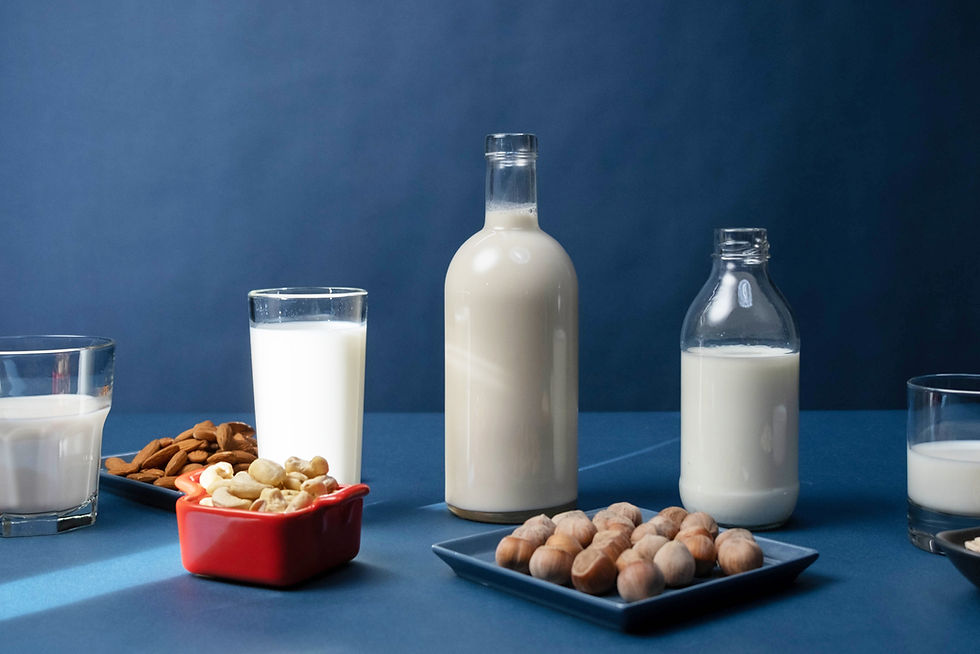Eat The Rainbow - Red Foods
- The Young Vegan

- Nov 14, 2021
- 3 min read
All foods have a different nutrient profiles, some are high in certain vitamins, others in proteins, this is one way in which foods can be grouped together. Another way of grouping foods is by colour. The colours found in foods come from pigments that develop within the cells of plants and animals and these pigments have nutrients of their own, called phytochemicals.

The Benefits of Eating Red Foods
Many phytochemicals are antioxidants, natural chemicals that help to protect our bodies from harmful substances called free radicals that can damage our cells. In countries where people eat a lot of foods that contain phytochemicals, like fruits and vegetables, there are lower rates of diseases like heart disease and diabetes.
Red coloured foods contain particular nutrients that are not found in foods of other colours, these include; lycopene, ellagic acid, quercetin and hesperidin. Each of these nutrients have a different advantage.
The health benefits of these pigments include:
Reducing the risk of certain cancers
Protecting the body against ageing
Defending the body against free radicals
Supporting skin and joint health
Lycopene, found in tomatoes and other foods, can help reduce blood pressure and cholesterol. It is more easily absorbed in the body when it’s cooked, for this reason cooked tomatoes have different health benefits to raw tomatoes, but both are good. Lycopene can be found in red carrots, watermelons, grapefruits, and papayas, but it is not present in strawberries or cherries.
Anthocyanin, an antioxidant, can be found in red berries, is a pigment that can appear red, purple, blue, or black, depending on the pH. Foods rich in anthocyanins include the blueberries, raspberries, black rice, and black soybeans and it is found in many different parts of plants, including leaves, stems, roots, flowers, and fruits. Another antioxidant that is found in numerous fruits and vegetables is ellagic acid. The highest levels of ellagic acid are found in raw chestnuts, walnuts, pecans, cranberries, raspberries, strawberries, and grapes. It is also found in peaches and pomegranates.
Hesperidin has antioxidant and anti-inflammatory effects and can be found primarily in citrus fruits. Hesperidin is thought to have beneficial effects on blood vessels and is used as a natural remedy for a number of health problems, including allergies and sinusitis. Hesperidin is also said to reduce inflammation and help fight cancer, but none of these claims have been proved. Although hesperidin may not be proven to have huge health benefits, eating the fruits that contain this chemical are, undoubtedly, good for health.
Fibre is also found in red coloured foods. There are two different types of fibre, dietary fibre and soluble fibre, both can be found in plants but is not found in animal products. Soluble fibre can dissolve in water, it absorbs water and slows the speed at which food travels through the gut. As the fibre dissolves and absorbs water it forms a gel like substance which can have protective and soothing properties. Dietary fibre does not dissolve in water, as it settles in the stomach it gives a feeling of fullness and helps to prevent overeating, it also adds bulk to stools, making waste easier to pass.
Vitamin A is important for growth and development, the maintenance of the immune system, and good vision. It is needed by the retina of the eye in the form of retinal, which combines with a protein to form the light-absorbing molecule necessary for both low-light (scotopic vision) and colour vision. It literally helps you to see in the dark.
Vitamin C (also known as ascorbic acid and ascorbate) is an essential nutrient involved in the repair of tissues, the formation of collagen, and the production of certain neurotransmitters. It is required for the functioning of several enzymes and is also important for immune system function and has the added benefit of being an antioxidant. Most animals can make their own vitamin C, but humans, some primates, most bats, some rodents, and certain other animals must eat foods that contain the vitamin as their bodies cannot synthesise it.
Different Red Foods
The chemicals that make foods appear red can be found in many different plants, fruits and vegetables from red carrots, purple corn and black beans to concord grapes. Some more common red foods are:
Apples
Watermelon
Red Chillies
Strawberries
Tomatoes
Cherries
Beetroot
Red Bell Peppers
Pomegranate
Raspberries
Fruits and vegetables contain vitamins, minerals, fibre, water and many other chemicals that are incredibly good for our health and it is easy to add them to our meals and everyday dishes, making them extra tasty and extra healthy. Add pomegranate seeds or cherry tomatoes to a green salad or cous cous or add strawberries to a bowl of porridge to boost the benefits.




شيخ روحاني
رقم شيخ روحاني
الشيخ الروحاني
الشيخ الروحاني
شيخ روحاني سعودي
رقم شيخ روحاني
شيخ روحاني مضمون
Berlinintim
Berlin Intim
جلب الحبيب